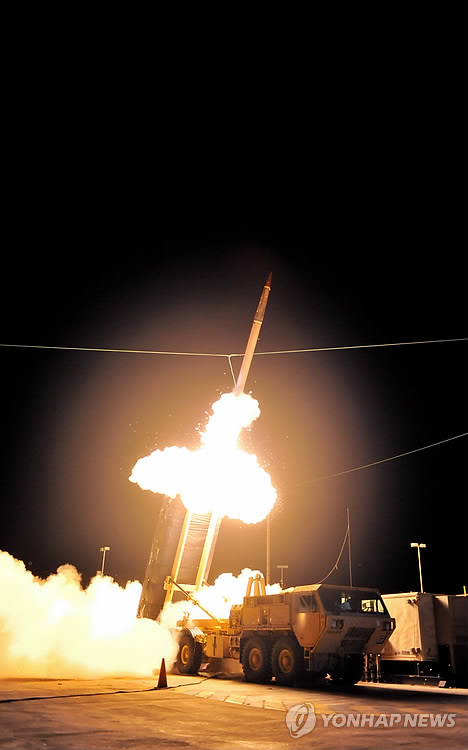A senior U.S. defense official confirmed Tuesday that Washington was considering deploying an advanced missile defense system to South Korea to better handle North Korean threats.
Deputy Secretary of Defense Robert Work said the U.S. and South Korea were in consultation over the possible deployment of the Terminal High-Altitude Area Defense system, a key element of the multilayered global U.S. missile defense program ― a sensitive issue that could strain Seoul’s ties with Beijing and Russia.
“As you said, we are considering sending a THAAD to South Korea,” Work said in response to a reporter’s question during a forum organized by the Council on Foreign Relations on U.S policy in the Asia-Pacific region.
“We are considering very carefully whether or not to put a THAAD in South Korea. We’re doing site surveys. We’re working with the government of South Korea now to determine if that is the right thing to do.”
Deputy Secretary of Defense Robert Work said the U.S. and South Korea were in consultation over the possible deployment of the Terminal High-Altitude Area Defense system, a key element of the multilayered global U.S. missile defense program ― a sensitive issue that could strain Seoul’s ties with Beijing and Russia.
“As you said, we are considering sending a THAAD to South Korea,” Work said in response to a reporter’s question during a forum organized by the Council on Foreign Relations on U.S policy in the Asia-Pacific region.
“We are considering very carefully whether or not to put a THAAD in South Korea. We’re doing site surveys. We’re working with the government of South Korea now to determine if that is the right thing to do.”

Stressing that the THAAD, once positioned on the peninsula, would become a crucial part of regional defense, Work added that it was very difficult to move a THAAD battery because of the work involved in setting up the system.
“These batteries are strategic assets. Moving them is a very, very important national-level decision,” he said.
Seoul’s Defense Ministry, however, denied that there were ongoing official talks between the allies over the deployment of the THAAD.
“We contacted Deputy Assistant Secretary of Defense for East Asia David Helvey, and he confirmed that there is no decision made yet over the deployment of the THAAD and there have not been any talks with Seoul over the issue,” a Seoul official told reporters.
During a Seoul forum in June, U.S. Forces Korea Commander Gen. Curtis Scaparrotti confirmed that Washington was considering deploying the THAAD to the peninsula to better deal with “evolving” missile threats from the North.
Seoul has so far maintained a cautious stance as the deployment of any core U.S. missile defense assets would be perceived as participation in the U.S.-led missile shield program. It also has concerns that upgrading its missile defense with the U.S. could cause diplomatic friction with China, its largest trading partner, as China and Russia believe they could be the targets of the U.S. missile defense program during a crisis.
The THAAD is a system to intercept incoming hostile missiles at altitudes of 40-150 kilometers after detecting the missiles with land-based radar with a range of 1,800 km. Beijing and Moscow are concerned that the high-tech radar could be used to glean intelligence about their militaries.
To avoid fraying ties with the regional powers of China and Russia, Korea has been working on developing its independent Korea Air and Missile Defense system ― a low-tier, multiple-interception program that destroys incoming missiles at altitudes of 40-50 km.
Amid China’s opposition to the deployment of the THAAD, speculation has surfaced that Seoul may allow Washington to bring in the THAAD without the radar system, as U.S. troops could get intelligence from radar deployed in Japan or on the peninsula.
By Song Sang-ho (sshluck@heraldcorp.com)
-
Articles by Korea Herald








![[KH Explains] Hyundai's full hybrid edge to pay off amid slow transition to pure EVs](http://res.heraldm.com/phpwas/restmb_idxmake.php?idx=644&simg=/content/image/2024/04/18/20240418050645_0.jpg&u=20240419100350)







![[From the Scene] Monks, Buddhists hail return of remains of Buddhas](http://res.heraldm.com/phpwas/restmb_idxmake.php?idx=652&simg=/content/image/2024/04/19/20240419050617_0.jpg&u=20240419175937)

![[KH Explains] Hyundai's full hybrid edge to pay off amid slow transition to pure EVs](http://res.heraldm.com/phpwas/restmb_idxmake.php?idx=652&simg=/content/image/2024/04/18/20240418050645_0.jpg&u=20240419100350)

![[Today’s K-pop] Illit drops debut single remix](http://res.heraldm.com/phpwas/restmb_idxmake.php?idx=642&simg=/content/image/2024/04/19/20240419050612_0.jpg&u=)